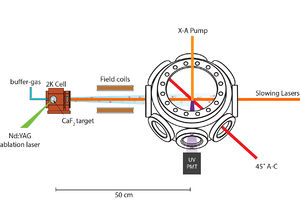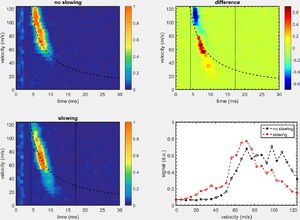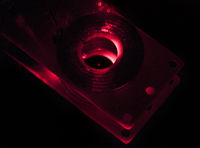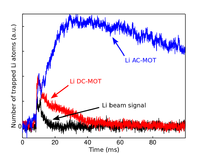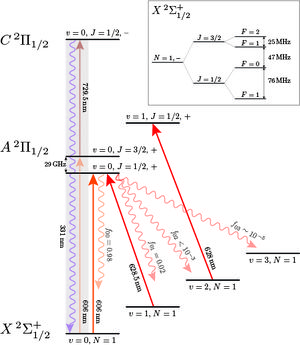Difference between revisions of "LaserCooling"
(→References) |
(→People) |
||
| Line 14: | Line 14: | ||
* Aakash Ravi | * Aakash Ravi | ||
* Loic Anderegg | * Loic Anderegg | ||
| + | * Ben Augenbraun | ||
'''Former Students and Postdocs''' | '''Former Students and Postdocs''' | ||
Revision as of 07:28, 27 August 2015
Contents
Research Overview
The goal of this experiment is to load a magneto-optical trap (MOT) with calcium monofluoride (CaF) using a two-stage buffer-gas beam source (for details on buffer-gas cells see [1-3]). We first ablate a solid precursor of CaF2 with a pulsed Nd:YAG laser. The hot molecular gas then thermalizes with ~1 K Helium buffer-gas and is extracted into a beam. In such a two-stage cell, the molecular beam has an average forward velocity of 50-60 m/s, while there are many particles below typical capture velocities (~ 40 m/s) of atomic MOTs. We made use of this fact demonstrating direct MOT loading for various lanthanides (see below for details). For molecules, however, the estimated capture velocity is much lower (~ 10 m/s) and a slowing stage is required to bring a sufficient number of molecules below the capture velocity. An additional challenge is the existence of magnetic dark states in molecules. We address this problem by switching the polarization and the magnetic field of the MOT very rapidly (~6 MHz) to depopulate those dark states (see below for details).
People
Grad Students
- Eunmi Chae
- Aakash Ravi
- Loic Anderegg
- Ben Augenbraun
Former Students and Postdocs
- Boerge Hemmerling
- Nick Hutzler
- Garrett Drayna
Collaborators
- Jun Ye (PI), Matthew Hummon, Mark Yeo, Alejandra Collopy, Yong Xia
Ye Group Ultracold Molecules Website
- Wolfgang Ketterle (PI)
Latest News
Laser slowing of CaF down to ~5 m/s
Recently, we have accomplished laser slowing of CaF molecules from a two-stage buffer gas beam source down to longitudinal velocities of approximately 5 m/s. Our scheme uses three lasers (one main transition and two for repump transitions) which are spectrally broadened to address the velocity spread of the source as well as the hyperfine structure of the molecules.
AC-MOT of Lithium
We realized an AC-MOT for Lithium-6 on the D1 line. This transition has magnetic dark states which reduce the efficiency of a regular DC-MOT configuration. A switching of the polarization and the magnetic field actively remixes the Zeeman substates and keeps the atom in the cooling cycle. Three different time traces comparing the beam signal without trapping fields, a DC-MOT and an AC-MOT are shown in the left figure. Both, the magnetic field coils and the polarization of the molasses laser beams are switched at a frequency of 6 MHz. The improvement in the lifetime using the AC configuration is quite evident. For further details on AC-MOTs see e.g. Phys. Rev. Lett. 110, 143001 (2013) and Phys. Rev. Lett. 101, 173201 (2008).
MOT paper accepted in New Journal of Physics
Our paper Buffer-gas loaded magneto-optical traps for Yb, Tm, Er and Ho has been accepted in New Journal of Physics.
Laser Cooling and Trapping of Diatomic Radicals (CaF)
We are investigating the laser slowing and magneto-optical trapping of diatomic molecules. Laser cooling of molecules requires buffer-gas cooling to produce samples of ground-state molecules which have necessary rotational phase space densities for current molecular laser cooling schemes. We use slow beam technology developed in our group [1-3] to reduce the amount of kinetic energy and number of cycled photons needed to bring molecules to rest in a 3D trap.
Currently, our group is working with the radical CaF. We have produced a slow, cryogenic beam of CaF with rotational cooling and we see slowing of molecules down to longitudinal velocities of ~ 5 m/s, following a scheme similar to the one used in [3-6].
Other groups working on laser cooling and slowing of diatomic molecules
- Yttrium Oxide: Jun Ye Group Ultracold Molecules Website
- Strontium Fluoride: Dave DeMille Group Website
- Calcium Fluoride: Ed Hinds Group Website
Buffer-Gas Loaded MOTs for Ytterbium, Thulium, Erbium and Holmium
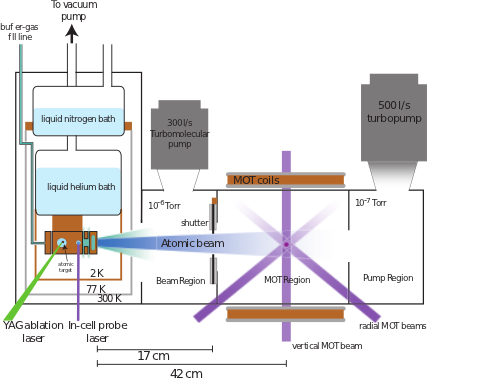
We first investigated laser cooling and trapping of atoms from a buffer-gas beam. We made the first buffer-gas loaded MOT, using Yb atoms as our species of interest. A schematic of the apparatus can be seen on the right. This MOT, which used no slowing of any kind (Zeeman slower, slowing laser, etc.), demonstrated the feature of our buffer gas beam technology, which we plan to use for a molecular MOT. Furthermore, this MOT demonstrated that, in principle, buffer-gas beam technology is compatible with 3D magneto-optical trapping. Owing to the universal nature of this source, we implemented MOTs for the lanthanides Ytterbium, Thulium, Erbium and Holmium with only a change of the ablation pre-cursor and the MOT laser frequency. We also demonstrate this flexibility in the case of Ytterbium by loading many different isotopes into a MOT by adjusting the detuning of the MOT laser frequency only. Below is a video which shows a picture of the Yb MOT fluorescence with the detuning being changed between the frames.
Thulium, Erbium and Holmium are highly magnetic species that are of interest for quantum simulation and quantum computation. These are refractory elements and have low loading rates due to the difficulties with oven sources. Our buffer-gas loaded MOTs circumvent these high temperature oven sources and allow loading rates over 10^8 /sec/shot, or over 10^9/sec cumulative. This technology could be used to co-load multiple species with little technological overhead (no multiple Zeeman slowers). In addition, we were able characterize the decay into metastable states. Our work on these lanthanide atoms is summarized in the following article:
Buffer-gas loaded magneto-optical traps for Yb, Tm, Er and Ho. B. Hemmerling, G. K. Drayna, E. Chae, A. Ravi, and J. M. Doyle, New Journal of Physics 16, 063070 (2014).
Video of Ytterbium isotope MOTs
The solid precursor used for ablation contains the natural abundance of Yb isotopes, i.e. 3% 170Yb, 14% 171Yb, 22% 172Yb, 16% 173Yb, 32% 174Yb and 13% 176Yb. The ablation process, as oppose to photoionization, lacking an isotope-selective character brings each isotope into the gas phase where it is subsequently cooled by the He buffer gas. Due to the absence of a Zeeman slower, each element can be loaded into the MOT by only correcting for the isotope shift in the frequency detuning of the molasses laser. The top graph in the video shows the in-cell absorption spectrum and the change in laser frequency (The frequencies given in the video are measured with our wavemeter and thus are NOT precision measurements of the frequencies for the Yb transitions. For precise values, the reader is e.g. referred to PRA 82, 043408 (2010).) Note, that one of the isotopes, 173Yb, does not form a magneto-optical trap. This is due to the presence of magnetic dark states.
References
- N. R. Hutzler, H.-I Lu, and J. M. Doyle, The Buffer Gas Beam: An Intense, Cold, and Slow Source for Atoms and Molecules, Chem. Rev., 112, 4803 (2012)
- H.-I Lu, J. Rasmussen, M. J. Wright, D. Patterson, and J. M. Doyle, A cold and slow molecular beam, Phys. Chem. Chem. Phys. 13, 18986 (2011)
- D. Patterson and J. M. Doyle, Bright, Guided, molecular beam with hydrodynamic enhancement, J. of Chem. Phys. 126, 154307 (2007)
- E. S. Shuman, J. F. Barry, D. R. Glenn, and D. DeMille, Radiative Force from Optical Cycling on a Diatomic Molecule, Phys. Rev. Lett. 103, 223001 (2009)
- E. S. Shuman, J. F. Barry, and D. DeMille, Laser cooling of a diatomic molecule, Nature 467, 820 (2010)
- M. T. Hummon, M. Yeo, B. K. Stuhl, A. L. Collopy, Y. Xia, and J. Ye, 2D Magneto-Optical Trapping of Diatomic Molecules, Phys. Rev. Lett. 110, 143001 (2013)
- M. Harvey, A. J. Murray, Cold Atom Trap with Zero Residual Magnetic Field: The ac Magneto-Optical Trap , Phys. Rev. Lett. 101, 173201 (2008)
- V. Zhelyazkova, A. Cournol, T. E. Wall, A. Matsushima, J. J. Hudson, E. A. Hinds, M. R. Tarbutt, and B. E. Sauer, Laser cooling and slowing of CaF molecules , Phys. Rev. A. 89, 053416 (2014)
- B. Hemmerling, G. K. Drayna, E. Chae, A. Ravi, J. M. Doyle, Buffer gas loaded magneto-optical traps for Yb, Tm, Er and Ho, New Journal of Physics 16, 063070 (2014)
- J. F. Barry, D. J. McCarron, E. B. Norrgard, M. H. Steinecker, and D. DeMille, Magneto-optical trapping of a diatomic molecule, Nature 512, 286 (2014)
- D. J. McCarron, E. B. Norrgard, M. H. Steinecker, D. DeMille, Improved magneto-optical trapping of a diatomic molecule, arXiv:1412.8220
- M. Yeo, M. T. Hummon, A. L. Collopy, B. Yan, B. Hemmerling, E. Chae, J. M. Doyle, J. Ye, Rotational state microwave mixing for laser cooling of complex diatomic molecules, Phys. Rev. Lett. 114, 223003 (2015)
